Coordinators:
Amar Ayyash (USA)
Mars Muusse (Netherlands)
thayers rings
thayers PDF's
thayers 1cy August
thayers 1cy September
thayers 1cy October
thayers 1cy November
thayers 1cy December
thayers 2cy January
thayers 2cy February
thayers 2cy March
thayers 2cy April
thayers 2cy May
thayers 2cy June
thayers 2cy July
thayers 2cy August
thayers 2cy September
thayers 2cy October
thayers 2cy November
thayers 2cy December
thayers 3cy January
thayers 3cy February
thayers 3cy March
thayers 3cy April
thayers 3cy May
thayers 3cy June
thayers 3cy July
thayers 3cy August
thayers 3cy September
thayers 3cy October
thayers 3cy November
thayers 3cy December
thayers sub-ad January
thayers sub-ad February
thayers sub-ad March
thayers sub-ad April
thayers sub-ad May
thayers sub-ad June
thayers sub-ad July
thayers sub-ad August
thayers sub-ad September
thayers sub-ad October
thayers sub-ad November
thayers sub-ad December
thayers ad January
thayers ad February
thayers ad March
thayers ad April
thayers ad May
thayers ad June
thayers ad July
thayers ad August
thayers ad September
thayers ad October
thayers ad November
thayers ad December
|
Thayer's Gull 2cy May (1st basic moult)
Below you will find a description of Chapter 36 THAYER'S GULL Larus thayeri, as published in one of the best Gull publication: "Gulls of the Americas" by Steve Howell & Jon Dunn.
"we" in the text below refers to the original authors. If any errors occur in this text, please let me know and mail to marsmuusseatgmaildotcom.
PART 1: IDENTIFICATION SUMMARY & TAXONOMY
PART 2: FIELD IDENTIFICATION SIMILAR SPECIES - ADULT
PART 3: FIELD IDENTIFICATION SIMILAR SPECIES - 1ST CYCLE
PART 4: FIELD IDENTIFICATION SIMILAR SPECIES - 2ND CYCLE
PART 5: RARER SPECIES
PART 6: DESCRIPTION AND MOLT - ADULT & 1ST CYCLE
PART 7: DESCRIPTION AND MOLT - 2ND & 3RD CYCLE
BELOW: PART 7
Second Cycle.
Complete PB2 molt (May/June-Sept./Oct.) into second basic plumage. Some birds bleach strikingly by early summer, before PB2 is very advanced - and new B2 feathers can look contrastingly dark. Head, neck, and underparts variably mottled and streaked gray-brown and whitish; head and chest of some birds bleach to mostly whitish by midwinter. Upperparts vary from fairly boldly barred and checkered brown and whitish overall to a mostly grayish back contrasting with upperwing coverts that are barred and spotted gray-brown and whitish. Tertials dark brown to dark gray-brown with speckled and notched whitish tips and distal edging. Wingtips blackish brown, contrastingly darker than tertials, with whitish fringes widest at tips. Upperwing pattern of remiges similar to first cycle, but inner primaries average paler and grayer, secondaries often paler and not forming a strong dark bar; P10 rarely has a small diffuse mirror. Distal tail band blackish brown to dark brown with white tail base more sparsely and finely marked than first cycle. Wing-linings medium brown with underside of primaries often reflectively pale. Eyes brownish to pale, bill typically flesh pink to pale greenish with black distal third and pale horn tip (sometimes dull like first winter), legs flesh pink. Partial PA2 molt (Sept.-Apr.; often includes some upperwing coverts) produces second alternate plumage: head, neck, and underparts whiter, mottled dusky and whitish (sometimes bleaching and wearing to mostly white by summer), back more extensively gray in contrast to faded upperwing coverts; some birds attain a few gray upperwing coverts, especially median coverts. Eyes brownish to dirty pale lemon, orbital ring can be pinkish in summer. By summer, some birds have yellowish bill with reddish gonydeal smudge and black distal band. Legs flesh pink.
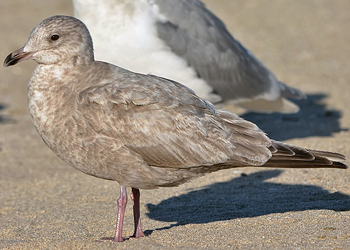 |
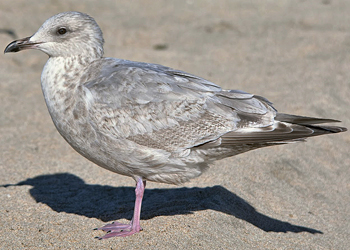 |
| Thayer's Gull 2nd cycle, mid-January 2014, central California, US (Amar Ayyash). No sign of a mirror here (typical of Thayer's and unlike Kumlien's). Primaries are darkest part of the bird, dark brown, with neat fringes confined to the tip of each feather.
As is typical, the closed wing is predominantly brown and the tertials have solidly brown centres, and rather uniform mid brown greater coverts.
This bird has no grey in the scapulars. |
Thayer's Gull 2nd cycle, mid-January 2014, central California, US (Amar Ayyash). Bi-coloured bill hardly developed in this bird (much like 1st cycle here), dark iris, and the legs are clean, deep pink.
No sign of a P10 mirror. This bird has contrastingly patterned coverts with darker shaft streaks on median coverts and vermiculation on tips of tertials and all visible greater coverts. Few greyish feathers in the scapulars. |
 |
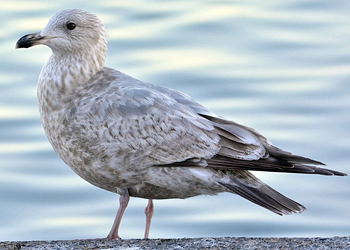 |
| Thayer's Gull 2nd cycle, mid-January 2014, central California, US (Amar Ayyash). Bi-coloured bill, dark iris, legs are clean, deep pink. Primaries are darkest part of the bird, dark brown, with neat fringes confined to the tip of each feather.
As is typical, the closed wing is predominantly brown and the tertials have solidly brown centres, and rather uniform mid brown greater coverts. Much grey in the scapulars. |
Thayer's Gull 2nd cycle, mid-January 2014, central California, US (Amar Ayyash). The underside of the longest primary (P10) is visible: no sign of a mirror here (typical of Thayer's and unlike Kumlien's). Primaries are darkest part of the bird, dark brown, with neat fringes confined to the tip of each feather. This bird has contrastingly patterned coverts with darker shaft streaks and vermiculation on tips of tertials. This bird has a few grey feathers in the scapulars. |
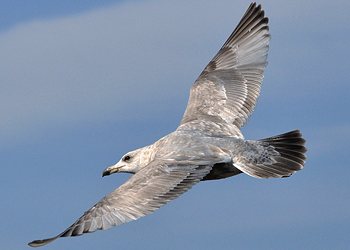 |
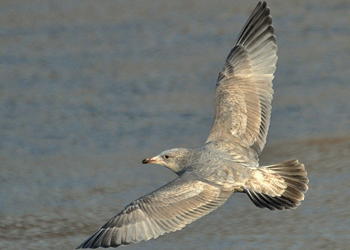 |
| Thayer's Gull 2nd cycle, November 30 2013, Lake County, IL (Amar Ayyash). P10 fully grown. Several grey scapulars. |
Thayer's Gull 2nd cycle, January 01 2012, Tukwila, WA (Amar Ayyash). Second gen flight feathers. No mirror on P10. Concolorous greater coverts. |
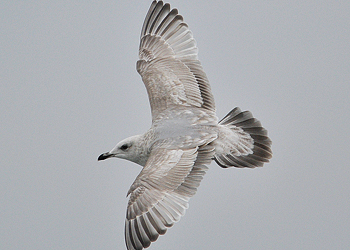 |
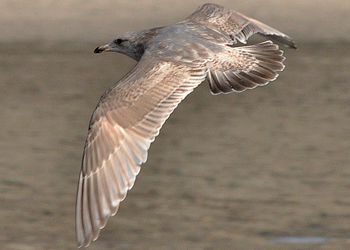 |
| Thayer's Gull 2nd cycle, January 13 2013, Lake County, IL (Amar Ayyash). Second gen flight feathers. No mirror on P10. Concolorous greater coverts. Already with much grey in the scapular region. |
Thayer's Gull 2nd cycle, February 03 2013, Boulder County, CO (Amar Ayyash). Marked dark outerwebs of outermost primaries. No mirror on P10. Part of the scapular region grey, but all wing-coverts and tertials still pale brown. Dark iris and bi-coloured bill. |
Third Cycle.
Complete PB3 molt (May/June-Oct.) produces third basic plumage. Head, neck, and underparts white with variable dusky streaking and mottling. Upperparts pale gray, usually with variable brown wash to upperwing coverts, brown tertial centers. Rump and tail white with variable dark brown to blackish brown distal tail band (tail varies from all white to having a fairly broad dark band). Wingtips blackish brown to slaty blackish, usually with a white P10 mirror and sometimes a small P9 mirror; wingtips at rest show whitish to distinct white tips. Upperwings mostly gray, mixed with brown (especially on primary coverts), with dark outer webs to outer primaries (creating two-tone pattern), 1-2 white mirrors, and white trailing edge to secondaries and inner primaries. Underwings mostly white with variable brown markings on coverts, outer primaries silvery gray with a dark subterminal band and whitish tongue-tips hinting at adult pattern. Eyes brownish to pale lemon; bill flesh to dull pale greenish with black distal band and pale tip; legs flesh pink. Partial PA3 molt (Sept.-Mar./Apr.) into third alternate plumage: dark markings on head and neck reduced to absent; bill brightens in spring and in summer can be indistinguishable from adult or have dark distal marks. White tips to outer primaries may be lost by wear. Adult plumage attained by complete PB4 molt (May/June-Oct./Nov.) but fourth-cycle birds may retain signs of immaturity on alula, primary coverts, and tail.
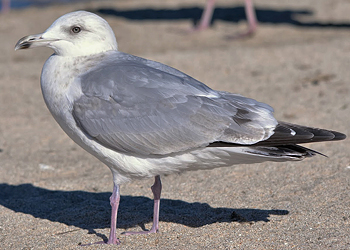 |
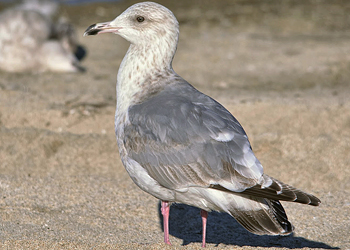 |
Thayer's Gull 3rd cycle, mid-January 2014, central California (Amar Ayyash). No contrast between wings and scapulars, all adult-like grey, but some feathers with brown wash or delicate vermiculation. Tertials with dark centres.
Much black in tail and white tips on outer primary hardly developed. Black band on bill. |
Thayer's Gull 3rd cycle, mid-January 2014, central California (Amar Ayyash).
Typically, no contrast between wings and scapulars, here many coverts still with brown tones. Central tertials with dark centres.
Still much black in tail and primaries a pale brown.
Much black in bill. |
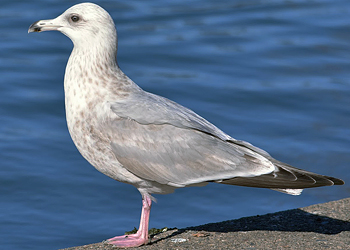 |
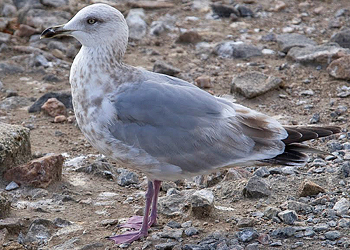 |
Thayer's Gull 3rd cycle, mid-January 2014, central California (Amar Ayyash). Still looking immature, but note typical pattern on 3rd gen secondaries: grey centres with white tips. Wings and scapulars all adult-like grey. White tips on outer primary hardly developed.
Much black in bill. |
Thayer's Gull "Cipriana" 1st cycle - adult, February 2008 - March 2013, Lago Fish farm - San Cibrao Harbour, Lugo, N Spain. Out-of-range bird, with pale iris in immature plumage. |
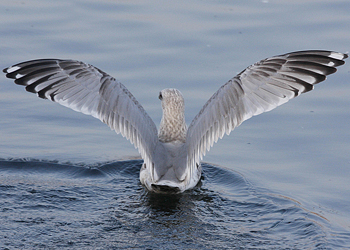 |
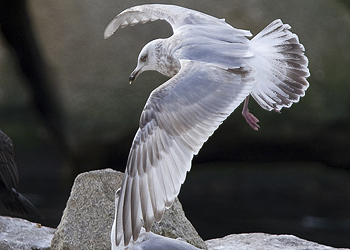 |
| Thayer's Gull 3rd cycle, November 21-22 2009, Duluth, MN (Erik Bruhnke). Third generation P9 already with thayeri pattern. Note much black in tail. |
Thayer's Gull "Cipriana" 1st cycle - adult, February 2008 - March 2013, Lago Fish farm - San Cibrao Harbour, Lugo, N Spain. Out-of-range bird, with pale iris in immature plumage. |
HYBRIDS
Presumably with Kumlien’s [Gaston & Decker 1985; Knudsen 1976; Snell 1989 & 2002], but extent of hybridization difficult to assess (see Taxonomy and introduction to Iceland Gull complex); hybridization seems possible with Iceland Gull in the Canadian High Arctic. [Howell and Mactavish 2003].
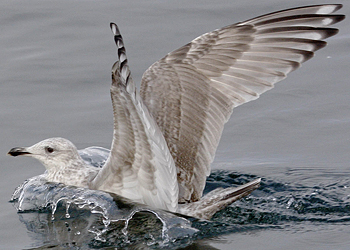 |
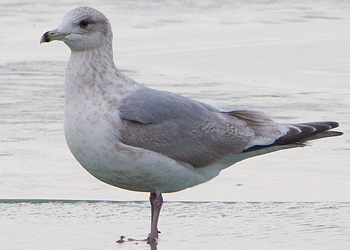 |
| Thayer's Gull (?) 2nd cycle, November 17-19 2009, Wisconsin Point, Superior, WI (Erik Bruhnke). Second generation P9-P10 show pattern of mirrors. Overall coloration in line with Thayer's (too dark for Kumlien's), but such well-marked 2nd gen outer primaries are (at least) rare in West Coast 2nd cycle Thayer's. Could be an influence of Kumlien's? |
Thayer's Gull - Kumlien's intergrade (?) 3rd cycle, December 30 2010, Chicago, IL (Ryan Sanderson). Mirror on P10 and secondaries show large white tips. Long bill and grey saddle. In many ways resembling Thayer's Gull, but already in 3rd cycle there is hardly any sub-terminal marking on P5, and normally there will be decreasing amount of marking in the wingtip in subsequent years, hence in full adult plumage this bird will probably develop a wingtip closer to Kumlien's. |
|
 Thayer's Gull 1st cycle (2CY), May 21 2012, Anchor Point, Kenai Peninsula, Alaska. Picture: Tom Johnson. Thayer's Gull 1st cycle (2CY), May 21 2012, Anchor Point, Kenai Peninsula, Alaska. Picture: Tom Johnson. |
 Thayer's Gull (thayeri)
Thayer's Gull (thayeri) Thayer's Gull 1st cycle (2CY), May 21 2012, Anchor Point, Kenai Peninsula, Alaska. Picture: Tom Johnson.
Thayer's Gull 1st cycle (2CY), May 21 2012, Anchor Point, Kenai Peninsula, Alaska. Picture: Tom Johnson.














